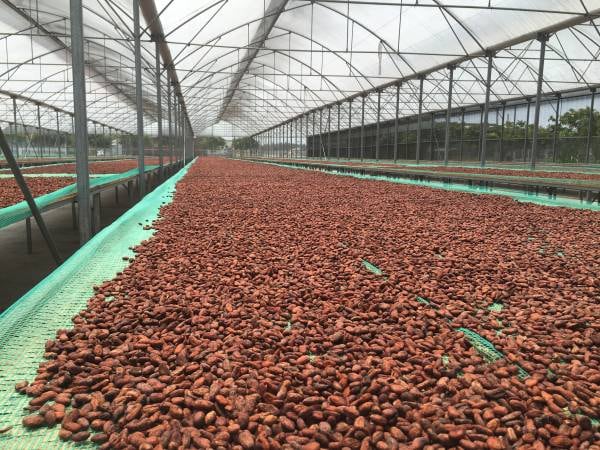The ICCO plans to award Vietnam fine flavor status for 40% of the country’s cocoa exports.
The Southeast Asian nation will join 17 other countries that have fine flavor designation under Annex C of the International Cocoa Agreement 2010, including Ecuador, Madagascar and Indonesia.
Vietnam was adjudged a fine flavor nation at an ICCO panel meeting on September 18, 2015, but is expected to be formally awarded recognition at the ICCO’s World Cocoa Conference in the Dominican Republic this May.
Belize, Guatemala, Honduras and Panama are also on course to gain fine flavor status for 50% of exports, while 100% of Nicaragua’s exports is set to gain the title.
Acidic with fruity notes
Fine flavor is distinguished for its quality over bulk cocoa by an ICCO panel featuring representatives from firms such as Valrhona, Nestlé and Casa Luker.
Price premium: Fine flavor benefits
According to the ICCO, fine flavor cocoa, accounts for about 6% of global cocoa exports. It says there is strong growth in demand for fine flavor driven by growing premium and single origin chocolate markets. Ecuador is the leading fine flavor producer. The ICCO estimates fine flavor cocoa typically commands between $3,500 and $5,000 per metric ton (MT) compared to $3,000 to $3,500 for bulk cocoa. Some high-end fine cocoa can fetch as much as $10,000 per MT, it says.
Ed Seguine of Guittard Chocolate, and founder of Seguine Cacao Cocoa & Chocolate Advisors, is the panel’s chair.
He told ConfectioneryNews at the recent Cocoa Revolution conference, that Vietnam had showed a part of its cocoa exports were valued by the market.
"They created a punch-list of all the buyers of cocoa that are the premium chocolate makers,” he said.
"This is an emerging region. Vietnam has a history of unbalanced acidic cocoa so as a producing country, the bulk of the sales have not been highly valued.”
But he said the country's output was in transition as a portion is produced via controlled drying and fermentation, producing a more balanced flavor.
"It's a Trinitario-type that generally expresses significant fresh fruit notes, sometimes some brown fruit notes and occasionally in descending order, some floral notes,” he said.
Why 40%?
Vietnam’s 40% fine flavour status was reached by determining the amount of exports that command a significant premium above the market price for bulk cocoa.
Indonesia was recognized as a fine flavor cocoa nation in March 2011, but only for 1% of its exports.
Only countries can apply for ICCO fine flavor cocoa status, but Vietnam’s application was supported by consultation with Puratos Grand-Place and Marou Chocolate.
Puratos Grand-Place is the country’s biggest cocoa buyer and has established a drying and fermentation center in Ben Tre in collaboration with Mars as it takes a vertical approach to chocolate production.
Gricha Safarian, managing director of Puratos Grand-Place, told this site “We are investing a lot of resources including human resources and capital to develop this industry in Vietnam.”
He said fine flavor cocoa status was good news for the country.
“…It’s a great recognition that the quality of the beans and the fermentation is good enough to be compared with countries like Vanuatu and Trinidad & Tobago,” he said.

A new crop
Vietnam has three cocoa growing regions: the Western Highlands, Mekong Delta and the Southeast region,
All beans are fermented
Mars estimates between 2004 and 2014, public and private entities have invested $30-40m in the Vietnamese cocoa sector. The average yield for a Vietnamese cocoa farm in 2015 was 850 kg of dry fermented beans per hectare. All of the nation’s cocoa is fermented. By comparison, fermentation is not widely practised in Asia top cocoa-producing nation Indonesia. Around 2,200 MT (40% of total production) of Vietnam’s cocoa is certified according to the UTZ standard. Source: Vietnam Cocoa Committee
Cocoa was formally introduced to the country mainly by NGO-funded projects around 10 years ago.
Vietnam’s cocoa growing area peaked in 2012 at 25,700 hectares, but has been in decline since last year when it reached 11,229 hectares as farmers moved to competing crops, according to the Ministry of Agriculture and Rural Development.
Cargill had been active in Vietnam cocoa buying since 2004, but pulled out in 2014, amid the decline in planting area.
Economic viability for farmers
Hai Lam Dinh, Vietnam cocoa development manager at Mars, said during the Cocoa Revolution conference: “For the future of cocoa in Vietnam it must be economically viable. If the farmer doesn’t get a good income from cocoa they will chop that cocoa tree.”
Mars supported Nam Lang University to establish a cocoa center of excellence in Vietnam in the mid-1990s.
Lam Dinh said cocoa in Vietnam needed to yield around 2 kg per tree to compete on price with crops like coffee. Average Vietnamese cocoa yields were at 0.52 kg per tree in 2012, according to a study by WASI (the coffee and cocoa research institute).
A 2015 study by KPMG found Vietnamese farmers in the Mekong Delta could earn an average income per hectare over triple the amount from competing crops such as pomelo and coffee in 2015 compared to cocoa.
